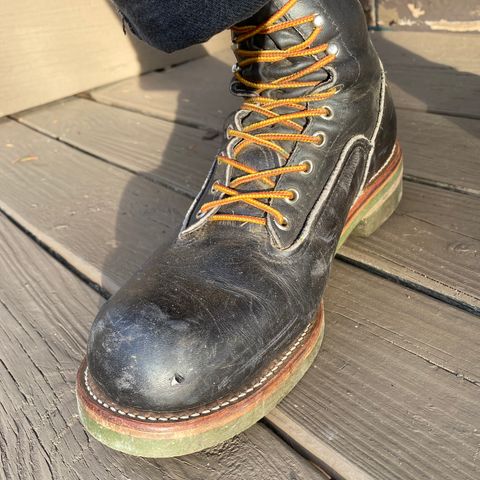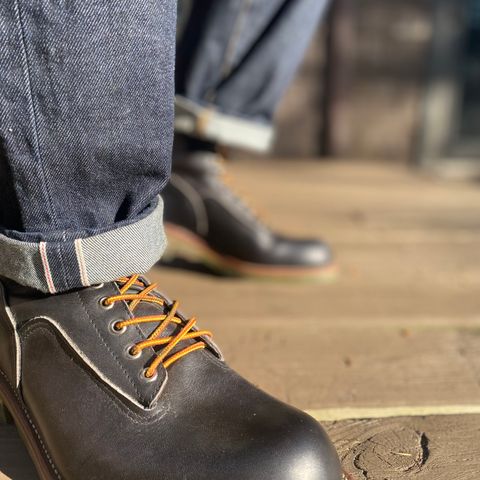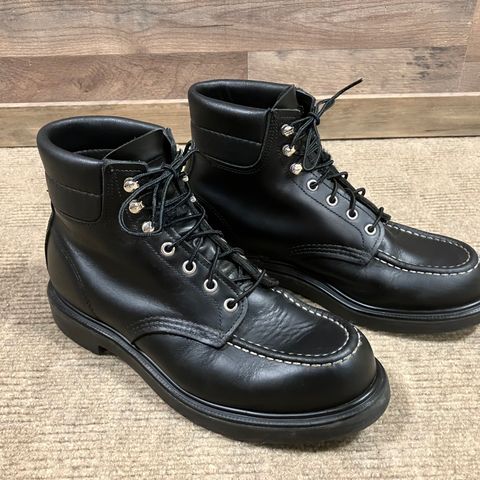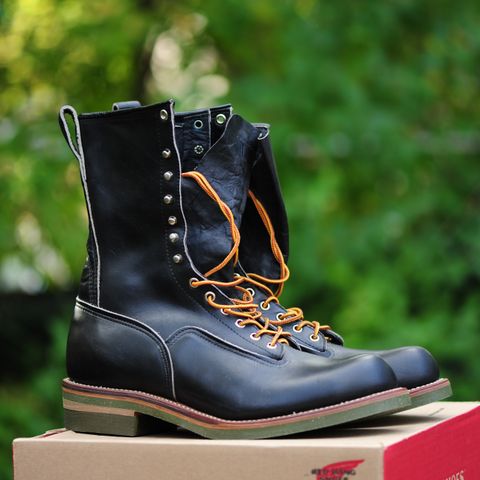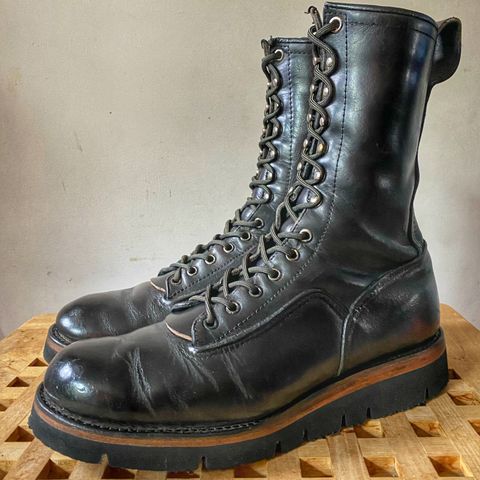About
S.B. Foot Black Chrome is a black-colored chrome-tanned leather produced by S.B. Foot Tanning Company in Red Wing, Minnesota. As a color variation of S.B. Foot Chrome, Black Chrome combines the fundamental characteristics of chrome tanning—flexibility, durability, and water resistance—with consistent black coloring throughout the leather. The material starts as wet blue chrome-tanned hides that receive black dye during S.B. Foot's finishing processes.
About
S.B. Foot Black Chrome is a black-colored chrome-tanned leather produced by S.B. Foot Tanning Company in Red Wing, Minnesota. As a color variation of S.B. Foot Chrome, Black Chrome combines the fundamental characteristics of chrome tanning—flexibility, durability, and water resistance—with consistent black coloring throughout the leather. The material starts as wet blue chrome-tanned hides that receive black dye during S.B. Foot's finishing processes.
Black Chrome exhibits the characteristic properties of chrome-tanned leather including soft hand feel, dimensional stability, and resistance to water and staining. Unlike leathers that develop patina over time, Black Chrome maintains its original black color throughout its lifespan, making it suitable for applications requiring consistent black appearance. The leather benefits from S.B. Foot's high-exhaustion chrome tanning processes that reduce environmental impact while producing highly stable, pliable material.
Chrome tanning characteristics
Black Chrome inherits the fundamental properties of chrome-tanned leather. The material is softer and more flexible than vegetable-tanned alternatives, with water-resistant properties resulting from the chrome salt treatment during tanning. The leather retains its black color for its entire lifespan without fading or developing the patina characteristic of vegetable-tanned leathers.
The flexibility of Black Chrome provides scuff and impact resistance through the leather's ability to flex rather than mark when subjected to stress. This softness makes the leather particularly suitable for footwear applications where comfort and break-in characteristics are important. The chrome tanning process creates cross-linking between chromium and collagen fibers in the hide, producing the stable structure that provides Black Chrome's durability and dimensional stability.
Black Chrome can be produced in relatively short timeframes compared to vegetable tanning, with the chrome tanning process completing in three to 24 hours. The material maintains consistent properties across production batches, with the black dyeing process providing uniform coloring throughout the leather thickness.
Production process
Black Chrome production follows S.B. Foot Tanning Company's high-exhaustion chrome tanning methodology. The leather begins as wet blue hides—pre-processed chrome-tanned material that arrives at S.B. Foot's Red Wing facilities having already undergone initial chromium salt curing. This chrome-tanned base provides the foundation for Black Chrome's structure, flexibility, and water resistance.
During finishing operations, the leather receives black dye to achieve its characteristic coloring. The dyeing process for chrome-tanned leather allows for deep, consistent color penetration, with the black dye bonding to the chrome-tanned leather structure. Unlike some finishing processes that apply color only to the surface, the dyeing of chrome-tanned leather typically results in color throughout the material thickness.
S.B. Foot's high-exhaustion chrome tanning processes reduce chromium salt usage by 33 percent while increasing chrome utilization from 70 to 98 percent. This environmental improvement applies to all chrome-tanned leathers produced by the tannery, including Black Chrome. The process reduces chrome discharge waste from 3.8 kg per ton to 0.05-0.1 kg per ton, representing both environmental responsibility and manufacturing efficiency.
Applications
Black Chrome finds application in footwear construction where consistent black coloring and the characteristic properties of chrome-tanned leather prove beneficial. The material's flexibility, water resistance, and durability make it appropriate for various boot and shoe styles. The leather's ability to maintain its black color without fading suits applications where color consistency over the product's lifespan is desired.
The water-resistant properties of Black Chrome make it suitable for footwear exposed to moisture and varying weather conditions. The leather's resistance to staining and perspiration contributes to its functionality in work boot and casual footwear applications. The soft, flexible nature of the chrome-tanned leather provides comfort characteristics while maintaining structural integrity for footwear construction.
Beyond footwear, Black Chrome's properties suit leather goods applications requiring black coloring, water resistance, and flexibility. The material performs well in items such as straps, bags, and accessories where consistent black appearance and durability are required. The chrome tanning process provides dimensional stability that helps maintain the leather's shape and structure in various product applications.
Care and maintenance
Black Chrome requires straightforward maintenance due to its chrome-tanned nature and color-stable characteristics. Light cleaning with a damp cloth removes surface dirt and debris without affecting the leather's color or finish. The water-resistant properties of chrome-tanned leather provide some protection against moisture exposure, though allowing the leather to dry naturally at room temperature remains advisable after wet conditions.
The leather's color stability means it does not require conditioning to maintain its black appearance, as the color is integral to the leather structure rather than a surface treatment that might wear away. If conditioning is desired to maintain suppleness, products suitable for chrome-tanned leather can be applied sparingly. Over-conditioning should be avoided as it provides minimal benefit to chrome-tanned leather compared to vegetable-tanned alternatives.
Black Chrome does not develop patina or significant color changes through wear and aging. The leather maintains its original black coloring throughout its lifespan, with wear patterns typically manifesting as changes in surface texture rather than color variation. This consistent appearance characteristic makes Black Chrome suitable for applications where maintaining original color presentation is preferred over developing unique aging patterns.
References
"Home". S.B. Foot Tanning Co. Retrieved October 13, 2025.
"Chrome Tanned Leather Guide: Pros & Cons vs Vegetable Tanning". Von Baer. Retrieved October 13, 2025.
"Difference Between Wet Blue and Wet White Leather". Gruppo DANI Tannery. Retrieved October 13, 2025.
